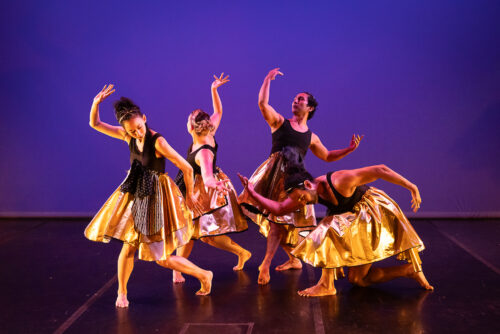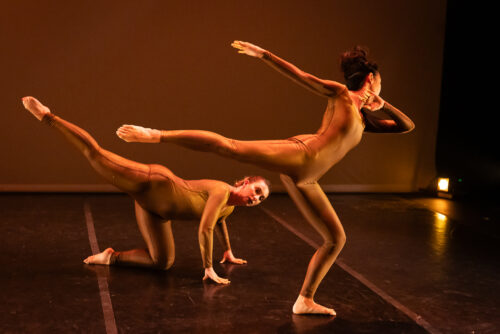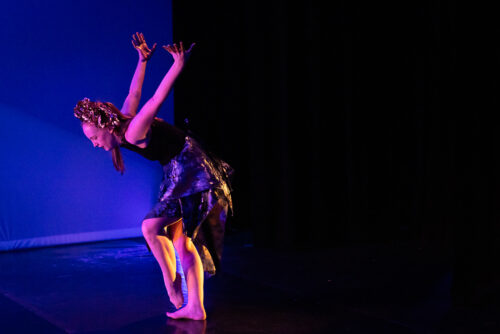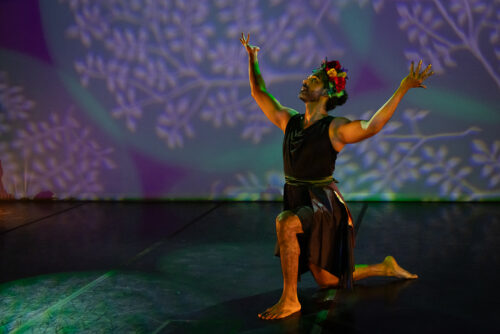A Tapestry of Femininity: Exploring The Pilot Dance Project’s “Aureate”

I imagine each member of the audience for The Pilot Dance Project’s evening-length work Aureate leaving The DeLuxe Theater in Houston’s Fifth Ward mentally clasping their own tendrils of meaning. Within the tapestry woven by Artistic Director Adam Castan͂eda and choreographer/designer Ashley Horn, one might focus on individual themes like the natural world, sacred iconography, mythology, feminine adornment, community, or the inherent light and beauty of humanity. For me, a cisgender woman in the transitional years between youth and senescence, Aureate resonated as a contemplative and appropriately complex exploration of femininity.
Aureate, which literally means golden and dually connotes something ornamental or flowery, leans into both meanings. Gold is an ancient symbol of wealth, divinity and enlightenment, and one of precious few assets historically available to women for ownership. From floral garland and halo-like headdresses to lamé sashes and skirts, every costume transformation—and there are many—incorporates some gilded embellishment. With trademark inventiveness and flare, Horn, who is also the production’s costume designer, presents a feast of fashion too-often rare in contemporary dance elsewhere but not here in Houston where she’s often involved.
Though Castan͂eda and Horn—who also appeared on stage as dancers—individually contributed choreography to the ten-part production, their similarly organic and unforced movement vocabulary felt seamless. Members of The Pilot Dance Project company and the broader Houston dance community were joined onstage by Castan͂eda’s Community Ensemble, resulting in a cast of 25 performers. Castan͂eda’s care and respect for his ensemble of mixed-ability movers with varying degrees of performance experience shone brightly, drawing two committed and evocative performances from the group during “Into the Vortex” and “Stargazing.”

Horn’s “Golden Tendons” duet featured The Pilot Dance Project company members Sarah Leung and Cloe Leppard. Dancers love to hate the one-piece unitards popularized during the postmodern dance movement but they were the perfect choice for Horn’s bare bones (pun intended) approach to movement echoing that same era. Initiation and release were used effectively by the pair of dancers to move their bodies as though instigated by tendons alone.
Castan͂eda’s triptych, “The Mary Suite,” and “Out of the Tomb of the Matriarchs/Zipporah’s Sorrow” both reference biblical women, highlighting their stoic strength through gestures of devotion and meaningful connection. Meanwhile, “The Beauty Contest of the Birds” draws from fable to depict a darker, more competitive side to feminine behavior. Presented midway through the program, the invigorating tone of this piece broke through the serene and atmospheric mystery established in earlier sections.

Playing upright bass and guitar respectively, Sonia Flores, founder and director of Aurum Son, and her bandmate Jesse Ward were seated on stage throughout Aureate. During “The Beauty Contest of the Birds,” Ward’s live-mix of mechanical cuckoo sounds added a touch of humor. Flores frequently lent soaring vocalizations to the soundscape. The fluid and partially-improvised score, which was clearly developed alongside the choreography, ranged from lush and expansive to understatedly groovy. Harmonious collaborations like this one prove live music, often considered a luxury in live dance, as fundamental as stage, lighting and costume design.
Lighting designer Edgar Guajardo is an experienced collaborator in dance and theater throughout the city. He is also the Production Manager at The DeLuxe Theater, a venue that opened as the Fifth Ward’s premiere Black movie theater in the 1940s and closed a few years after the civil rights movement ended segregation. Eventually reduced to a concrete shell, the theater sat empty until 2015 after a long march toward renovation through community revitalization efforts. Guajardo’s familiarity with the space was an asset, introducing rich color and projected shapes evoking architectural, sacred and natural elements. Small, portable lights smoothed the transitions from one section of the performance to another.
Femininity has long been intertwined with nature. The connection is present in language referencing Mother Earth or “virgin” forests and art depicting goddesses among flowers and animals. Horn’s “Blades of Grass” and “Strange Flowers” respectively appeared at the beginning and near the end of the production. In “Blades of Grass” the quartet’s elongated limbs and shifts of weight were rooted in unanimity. Plucked strings responded to small twists of that same quartet’s wrists in “Strange Flowers,” unified this time by individuality.

Brief duets, “Prologue: The Women” and “Goddess Garden,” bookended the production. “Goddess Garden” was a visual departure, adding vibrant color to the evening’s otherwise subdued palette of black, gold and blue. The gold leaf garland headdresses worn in the prologue by Ashley Horn and Angela Cohen, were now replicated in full color on the heads of Adam Castan͂eda and Kristina Prats to close the production. It is a detail that highlights the kind of thoughtfulness I appreciate most in contemporary dance choreography. What many of our artists may lack in flashy virtuosity or resources, the best of them make up for in sharp and cohesive creative decision-making.
Despite Aureate’s emphasis on women and femininity, how the dancers present or identify offstage was remarkably insignificant within the context of this onstage production. Roles, movement and costume did not adhere to traditional expectations in dance or society, captivating the diverse audience with a far more poignant exploration of the elements that universally symbolize and frequently shape femininity and the female experience.



Recent Comments